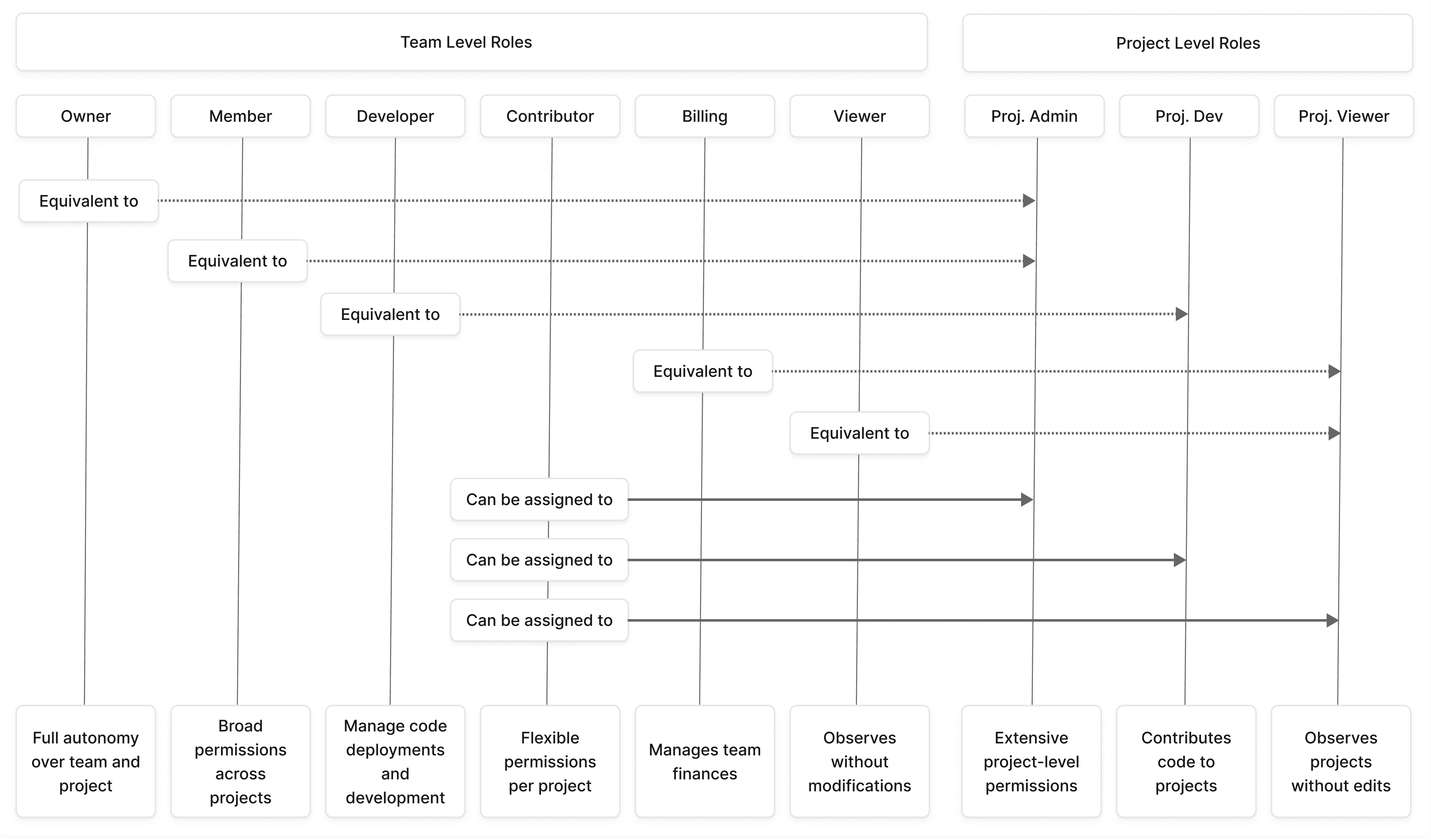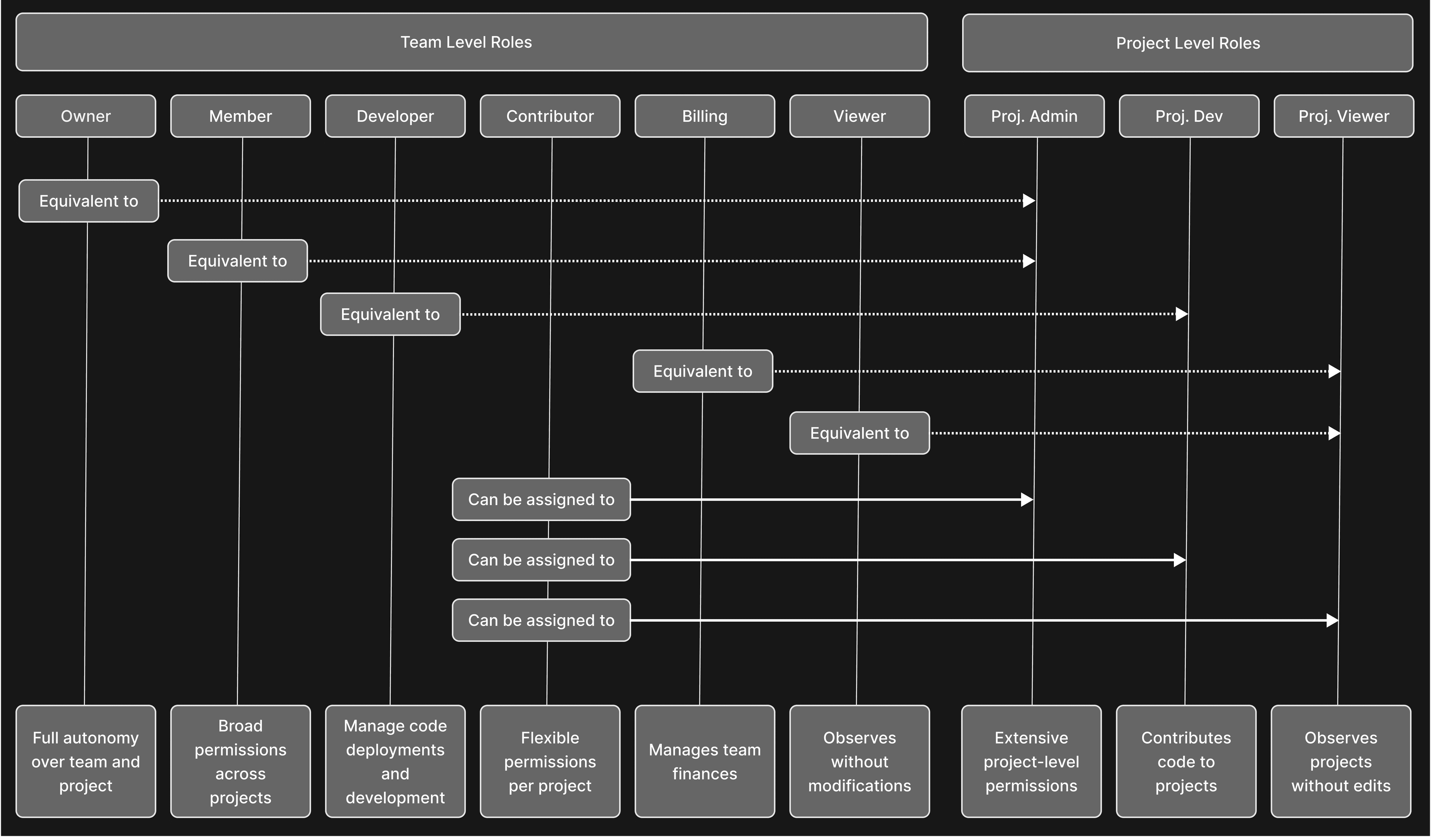Access Roles
Vercel distinguishes between different roles to help manage team members' access levels and permissions. These roles are categorized into two groups: team level and project level roles. Team level roles are applicable to the entire team, affecting all projects within that team. Project level roles are confined to individual projects.


The two groups are further divided into specific roles, each with its own set of permissions and responsibilities. These roles are designed to provide a balance between autonomy and security, ensuring that team members have the access they need to perform their tasks while maintaining the integrity of the team and its resources.
- Team level roles: Users who have access to all projects within a team
- Project level roles: Users who have restricted access at the project level. Only contributors can have configurable project roles
Team level roles are available on Pro and Enterprise plans
Team level roles are designed to provide a broad level of control and access to the team as a whole. These roles are assigned to individuals and apply to all projects within the team, ensuring centralized control and access while upholding the team's security and integrity.
- Owner and Member: Have the highest level of control. They can manage, modify, and oversee the team's settings, and all projects
- Developer: Can deploy to projects and manage environment settings but lacks the comprehensive team oversight that an owner or member possesses
- Billing: Primarily responsible for the team's financial management and oversight. The billing role also gets read-only access to every project
- Viewer: Has read-only access to the team's resources and projects
- Contributor: A unique role that can be configured to have any of the project level roles or none. If a contributor has no assigned project role, they won't be able to access that specific project. Only contributors can have configurable project roles
See the Team Level Roles Reference for a complete list of roles and their permissions.
The owner role is available on Pro and Enterprise plans
The owner role is the highest level of authority within a team, possessing comprehensive access and control over all team and project settings.
Key responsibilities
- Oversee and manage all team resources and projects
- Modify team settings, including billing and member roles
- Grant or revoke access to team projects and determine project-specific roles for members
- Access and modify all projects, including their settings and deployments
Access and permissions
Owners have unrestricted access to all team functionalities, can modify all settings, and change other members' roles.
Team owners inherently act as project administrators for every project within the team, ensuring that they can manage individual projects' settings and deployments.
Additional information
Teams can have more than one owner. For continuity, we recommend that at least two individuals have owner permissions. Additional owners can be added without any impact on existing ownership. Keep in mind that role changes, including assignment and revocation of team member roles, are an exclusive capability of those with the owner role.
See the Team Level Roles Reference for a complete list of roles and their permissions.
The member role is available on Pro and Enterprise plans
Members play a pivotal role in team operations and project management.
Key responsibilities
- Create deployments and manage projects
- Set up integrations and manage project-specific domains
- Handle deploy hooks and adjust Vercel Function settings
- Administer security settings for their assigned projects
Access and permissions
Certain team-level settings remain exclusive to owners. Members cannot edit critical team settings like billing information or invite new users to the team, this keeps a clear boundary between the responsibilities of members and owners.
Additional information
To assign the member role to a team member, refer to our Adding team members and assigning roles documentation.
See the Team Level Roles Reference for a complete list of roles and their permissions.
The developer role is available on Enterprise plans
Central to the team's operational functionality, developers ensure a balance between project autonomy and the safeguarding of essential settings.
Key responsibilities
- Create deployments and manage projects
- Control environment variables, particularly for preview and development environments
- Manage project domains
- Create a production build by committing to the
mainbranch of a project. Note that developers can create preview branches and preview deployments by committing to any branch other thanmain
Access and permissions
While Developers have significant access to project functionalities, they are restricted from altering production environment variables and team-specific settings. They are also unable to invite new team members. Note that the capability to become a project administrator is reserved for the contributor role. Those with the developer role cannot be assigned project level roles.
Developers can deploy to production through merging to the production branch for Git projects.
Additional information
To assign the developer role to a team member, refer to our Adding team members and assigning roles documentation.
See the Team Level Roles Reference for a complete list of roles and their permissions.
The contributor role is available on Enterprise plans
Contributors offer flexibility in access control at the project level. To limit team members' access at the project level, they must first be assigned the contributor role. Only after being assigned the contributor role can they receive project-level roles. Contributors have no access to projects unless explicitly assigned.
Contributors may have project-specific role assignments, with the potential for comprehensive control over assigned projects only.
Key responsibilities
- Typically assigned to specific projects based on expertise and needs
- Initiate deployments - Depending on their assigned project role
- Manage domains and set up integrations for projects if they have the project administrator role assigned
- Adjust Serverless Functions and oversee deploy hooks
Access and permissions
Contributors can be assigned to specific projects and have the same permissions as project administrators, project developers, or project viewers. They can also be assigned no project role, which means they won't be able to access that specific project.
See the Project level roles section for more information on project roles.
Additional information
To assign the contributor role to a team member, refer to our Adding team members and assigning roles documentation.
See the Team Level Roles Reference for a complete list of roles and their permissions.
The billing role is available on Pro and Enterprise plans
Specialized for financial operations, the billing role oversees financial operations and team resources management.
Key responsibilities
- Oversee and manage the team's billing information
- Review and manage team and project costs
- Handle the team's payment methods
Access and permissions
The billing role is designed to provide financial oversight and management, with access to the team's billing information and payment methods. This role also has read-only access to all projects within the team.
Additional information
The billing role can be assigned at no extra cost. For Pro teams, it's limited to one member while for Enterprise teams, it can be assigned to multiple members.
To assign the billing role to a team member, refer to our Adding team members and assigning roles documentation.
See the Team Level Roles Reference for a complete list of roles and their permissions.
The viewer role is available on Enterprise plans
An observational role, viewers are informed on team activities without direct intervention.
Key responsibilities
- Monitor and inspect all team projects
- Review shared team resources
- Observe team settings and configurations
Access and permissions
Viewers have broad viewing privileges but are restricted from making changes.
Additional information
To assign the viewer role to a team member, refer to our Adding team members and assigning roles documentation.
See the Team Level Roles Reference for a complete list of roles and their permissions.
Project level roles are available on Enterprise plans
Project level roles provide fine-grained control and access to specific projects within a team. These roles are assigned to individuals and are restricted to the projects they're assigned to, allowing for precise access control while preserving the overarching security and integrity of the team.
- Project Administrator: Team owners and members inherently act as project administrators for every project. Project administrators can create production deployments, manage all project settings, and manage production environment variables
- Project Developer: Can deploy to the project and manage its environment settings. Team developers inherently act as project developers
- Project Viewer: Has read-only access to a specific project. Both team billing and viewer members automatically act as project viewers for every project
See the Project Level Roles Reference for a complete list of roles and their permissions.
The project administrator role is available on Enterprise plans
Project administrators hold significant authority at the project level, operating as the project-level counterparts to team members and owners.
Key responsibilities
- Govern project settings
- Deploy to all environments
- Manage all environment variables and oversee domains
Access and permissions
Their authority doesn't extend across all projects within the team. Project administrators are restricted to the projects they're assigned to.
Additional information
To assign the project administrator role to a team member, refer to our Assigning project roles documentation.
See the Project Level Roles Reference for a complete list of roles and their permissions.
The project developer role is available on Enterprise plans
Project developers play a key role in working on projects, mirroring the functions of team developers, but with a narrowed project focus.
Key responsibilities
- Initiate deployments
- Manage environment variables for development and preview environments
- Handle project domains
Additional information
To assign the project developer role to a team member, refer to our Assigning project roles documentation.
See the Project Level Roles Reference for a complete list of roles and their permissions.
The project viewer role is available on Enterprise plans
Adopting an observational role within the project scope, they ensure transparency and understanding across projects.
Key responsibilities
- View and inspect all deployments
- Review project settings
- Examine environment variables across all environments and view project domains
Access and permissions
They have a broad view but can't actively make changes.
Additional information
To assign the project viewer role to a team member, refer to our Assigning project roles documentation.
See the Project Level Roles Reference for a complete list of roles and their permissions.
Was this helpful?